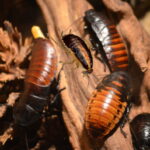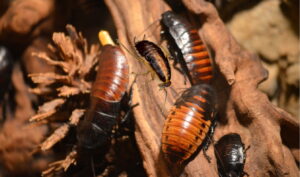Uncovering the Mystery: Palmetto Bug vs Cockroach – What’s the Difference?
When it comes to household pests the two we get asked about the most are the palmetto bug vs cockroaches, what are the differences, and what sets these two apart? What’s the difference between the cockroach and the palmetto bug? Are they the same thing or are there differences? There any many confusing posts online but, we’re here to set the record straight. In this post, we will we’ll look at their similarities and differences, how to control their infestations, and how to help prevent them in the future. So, let’s get started!
SECTION 1: Introduction
It can be difficult to differentiate and tell the difference between the cockroach and the palmetto bug. Some posts or sites will tell you there are the same thing. While they are from the same genotype and have similar characteristics, there are some notable differences. If you have a palmetto bug or cockroach problem in your home, it is important to know which pest you have in your home, and how to deal with them. In this article, we will discuss everything you need to know about palmetto bug vs cockroach and how to identify them.
SECTION 2: Overview of Palmetto Bug
Palmetto bug is a term used sometimes interchangeably with cockroach but, actually they are a group of several large and unique species of cockroach. They are also known as Florida woods cockroach (Eurycotis floridana.) The large cockroach species typically grow to be around 1.5 inches in length and can be found in many different climates. When alarmed, adults can eject an extremely foul-smelling directional spray up to 3 ft, or 1 m, which inspired several of its other common names: Florida skunk roach, Florida stinkroach, skunk cockroach, skunk roach, stinking cockroach, and stinkroach. They are usually dark brown or black in color and have a flattened, oval-shaped body. Palmetto bugs tend to be around 1.5 inches in length, have wings, and often seen flying. They can be found in many different climates. These pests prefer warm, humid environments and can be found in washrooms, laundry rooms, attics, basements, and any dark, damp areas in, or around your home. They like to feed on and dead or dying organic matter such as wood, newspaper, books, wallpaper, kraft paper, food scraps and other decaying material.
SECTION 3: Overview of Cockroach
Cockroaches are another common household pest. They are slightly smaller in size to palmetto bugs, but they vary in color from brown to black. Cockroaches have an oblong tube shaped body with six legs, two antenna, and some have wings, but most do not use them. They can be found in many different climates and have a wider range then the palmetto bug. You will find them in the same environments as the palmetto bug, but also some dryer areas of your home, especially the kitchen. They feed on some of the same materials as the palmetto bug, but prefer a good food scrape source such as, a kitchen, trash, or leftover food in a room, or area. Cockroaches can also spread some diseases, but are also know to cause mild to severe allergic reactions in some people. The learn more about the diseases and allergens, check out our earlier article that covers some of the known issues here.
SECTION 4: Similarities of the Cockroach vs Palmetto Bug.
As we’ve discussed, the palmetto bug and cockroach are very similar. The palmetto bug and the cockroach are similar in shape and color, and can live in the same environments feeding on similar organic material. They also can both present a problem with diseases and allergens causing an allergic reaction in some people. They can also both be very hard to get rid of once you have an infestation. This is why they are often mistaken to be the same bug, and are used interchangeably.
SECTION 5: Differences between Palmetto Bug and Cockroach
Although the palmetto bug and cockroach are similar, but there are some notable differences. The most obvious is the shape of their bodies. Palmetto bugs have a flattened, oval-shaped bodies and are about a half inch larger in size, at 1.5 inches, while cockroaches have a smaller oblong more tube shaped body. Palmetto bugs tend to also be more aggressive than cockroaches and they tend to be more active at night. Additionally, palmetto bugs are more capable of flying while cockroaches are not. The palmetto adults can eject an extremely foul-smelling directional spray up to 3 ft, or 1 m when alarmed.
SECTION 6: How to Control Palmetto Bug and Cockroach Infestations
The most important thing to help control an infestation is to identify it and treat it as early as possible. The best way to control these pests is to use a combination of chemical and non-chemical methods. If you’re looking for some DIY natural sprays and solutions you can make to use around your home without all the chemicals, check out our completely free download of natural formulas you can make at home by going here. Other Non-chemical methods include keeping your home clean, sealing cracks and crevices, and removing any sources of food and water
Chemical methods include commercial insecticides and baits you can purchase online, or from a big box store. You should also use sticky traps to monitor the infestation.
SECTION 7: Natural Ways to Get Rid of Palmetto Bug and Cockroach
If you want to avoid using chemical methods, there are several natural ways to get rid of the palmetto bug and cockroach. You can use natural oils such as peppermint, clove, and eucalyptus to repel the bugs. You can also use boric acid, diatomaceous earth, and neem oil to kill the bugs. For our completely free DIY download of natural formulas you can make at home for the palmetto bug, cockroach and many other household pest, check out our free download here. Additionally, you can use natural predators such as spiders and centipedes to get rid of the pests.
SECTION 8: Prevention Tips for Palmetto Bug and Cockroach Infestations
The best way to avoid a palmetto bug or cockroach infestation is to practice prevention. You should keep your home clean and free of food and water sources. You should also seal any cracks and crevices in your home and make sure to repair any plumbing leaks. Additionally, you should use a dehumidifier in damp areas.
SECTION 9: Conclusion
In conclusion, the palmetto bug and cockroach are similar with some distinct differences. Most important is to identify the problem, and take immediate and appropriate action. The best way to get rid of the palmetto bug and cockroach is to use a combination of chemical and non-chemical methods. Finally, the best way to prevent a palmetto bug or cockroach infestation is to keep your home clean and free of food and water sources and to seal any cracks and crevices. If you find yourself dealing with a palmetto bug or cockroach infestation, You can treat is yourself with both chemical and non-chemical methods, treat them with a DIY non chemical all natural formula you can make at home, or if you’re not up to dealing with the pest on your own, you can contact a professional pest control service for help.

